Data on Woman and Minority Participation in the SBIR Program at the Department of Defense
As part of its review of the SBIR program at the Department of Defense, the the National Academies of Sciences, Engineering, and Medicine committee on Capitalizing on Science, Technology, and Innovation collected data on woman and minority participation. These data are presented in the committee’s report, SBIR at the Department of Defense,1 and the report’s presentation of the data is reproduced in this appendix. The following excerpts from Chapter 2 of that report focus on Phase I awards and Phase II awards respectively.
Phase I SBIR Award Demographics2
Woman-owned Small Businesses (WOSB)
Congress mandated that the participation of women in the SBIR program be fostered and encouraged (Chapter 3 discusses additional evidence about female participation in the context of outcomes). The number of applications received from WOSBs remained largely flat over the study period (see Figure 2-8), even though the number of applications received from all companies declined. Overall, the number of awards to WOSBs remained constant, although with year-to-year variation, while the percentage of awards to WOSBs increased, especially after FY2008 (see Figure 2-9). Although overall numbers were relatively flat, there was
__________________
1National Research Council, SBIR at the Department of Defense, Washington, DC: The National Academies, 2014.
2The following text relating to Phase I awards appears on pp. 33-41 of National Research Council, SBIR at the Department of Defense, Washington, DC: The National Academies Press, 2014. Tables 2-2 and 2-3 have been removed from this excerpt because they do not relate to the quoted text.
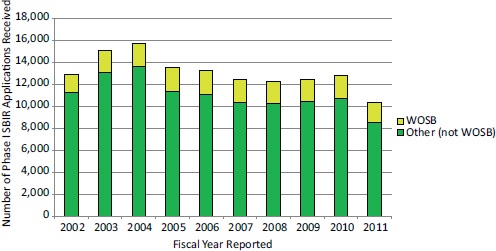
FIGURE 2-8 Phase I SBIR applications from woman-owned small businesses (WOSB), FY2002-2011.
SOURCE: DoD awards and applications database.
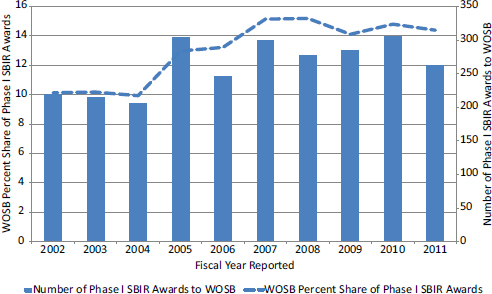
FIGURE 2-9 Phase I SBIR awards and award share for woman-owned small businesses (WOSB), FY2002-2011.
SOURCE: Data from DoD awards and applications database.
considerable variation in the awards to WOSBs made by individual components (see Figure 2-10).
In reading this data, it is important to keep in mind the very large role played by three WOSBs: Physical Optics, Intelligent Automation, and CFD Research. All were wholly or in part founded by their female owners, who continue to play a major role at each, so they clearly meet the Small Business Administration (SBA) standard for WOSBs. Combined, they accounted for about 34 percent of all Phase I awards to WOSBs during the study period; in some years, they accounted for much more than 40 percent, as illustrated in Figure 2-11 (numbers dropped sharply in FY2011 for reasons not yet understood). The figure also shows that the number of Phase I awards made to the remaining companies remained largely flat (until FY2011, for which only partial data are likely yet available). More generally, the top 20 WOSB awardees accounted for about 5.4 percent of all Phase I awards and about 42 percent of awards to WOSBs (see Table 2-4).
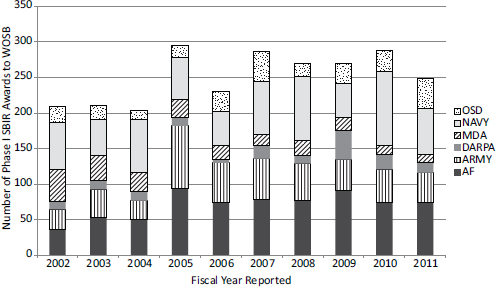
FIGURE 2-10 Phase I SBIR awards to woman-owned small businesses (WOSB) by component, FY2002-2011.
SOURCE: DoD awards and applications database.
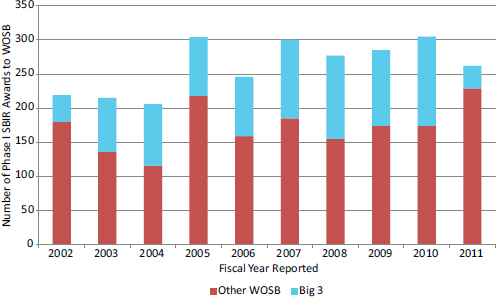
FIGURE 2-11 Distribution of Phase I SBIR awards among woman-owned small businesses (WOSB), FY2002-2011.
SOURCE: DoD awards and applications database.
TABLE 2-4 Top 20 WOSB SBIR/STTR Awardees, FY2002-2011
| Company Name | Number of Awards | Total Amount Awarded (Dollars) |
| Physical Optics | 325 | 30,767,174 |
| Intelligent Automation | 269 | 25,067,179 |
| CFD Research | 107 | 10,219,627 |
| Cybernet Systems | 63 | 6,107,428 |
| First RF | 52 | 5,209,574 |
| 21st Century Technologies | 43 | 4,201,388 |
| NAVSYS | 38 | 3,663,344 |
| Technology Assessment & Transfer | 37 | 3,402,382 |
| Composite Technology Development | 35 | 3,145,330 |
| UES Technologies | 35 | 3,361,153 |
| 21st Century Systems | 32 | 3,033,488 |
| Touchstone Research Laboratory Ltd. | 32 | 2,698,160 |
| Williams-Pyro | 31 | 2,718,785 |
| Ridgetop Group | 26 | 2,601,288 |
| Polaris Sensor Technologies | 25 | 2,452,270 |
| Pikewerks | 23 | 2,283,363 |
| New Span Opto-Technology | 22 | 1,945,801 |
| MP Technologies | 21 | 2,004,461 |
| Nu-Trek | 21 | 2,038,348 |
| Management Sciences | 21 | 2,019,714 |
| Top 20 WOSBs—total | 1,258 | 118,940,257 |
| All WOSBs—total | 2,963 | 282,087,120 |
| All Phase I awards FY2002-2011 | 23,224 | 2,222,884,156 |
| Top 20 WOSBs (percent of total) | 5.4% | 5.4% |
| All WOSBs (percent of total) | 12.8% | 12.7% |
SOURCE: Data provided by DoD.
Minority-owned Small Businesses (MOSB)
The number of Phase I applications by MOSBs declined steadily from a peak of more than 2,300 in FY2004 to a little more than 1,000 in FY2011 (see Figure 2-12). This decline mirrors the overall decline in applications experienced at DoD during the study period (see Figure 2-13).
Figure 2-14 summarizes awards to MOSBs by the different components (excluding components that provided less than 100 awards total to MOSBs). There was substantial variation over time, in particular at Army, as well as a long-term decline at MDA.
As with WOSBs (and indeed all awards), awards were concentrated in specific companies. Table 2-5 shows that the top 20 MOSB awardees accounted for about 2.4 percent of all awards and 28 percent of MOSB awards.
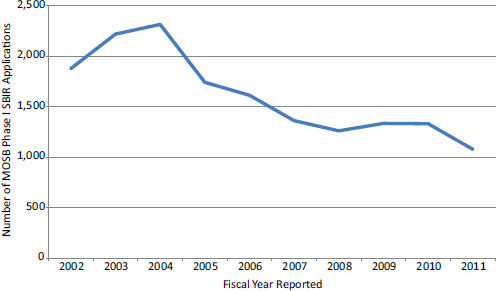
FIGURE 2-12 Phase I SBIR applications from minority-owned small businesses (MOSB), FY2002-2011.
SOURCE: DoD awards and applications database.
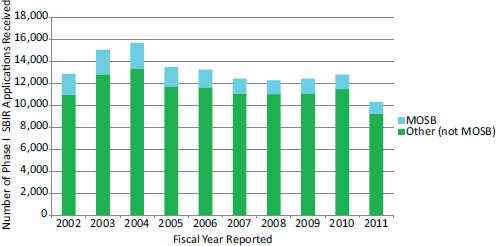
FIGURE 2-13 Phase I SBIR applications by minority-owned small businesses (MOSB) and Other Companies, FY2002-2011.
SOURCE: DoD awards and applications database.
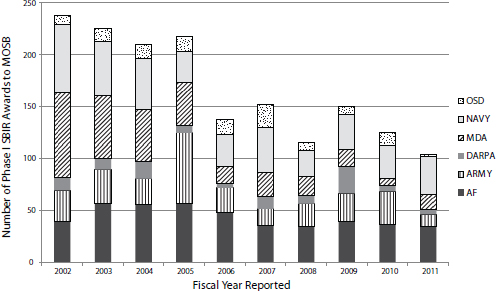
FIGURE 2-14 Phase I SBIR awards to minority-owned small businesses (MOSB) by component, FY2002-2011.
NOTE: DoD data for WOSB and MOSB are intrinsically inaccurate. Each record reports which boxes the company checked when applying, and agency staff acknowledge that companies sometimes fail to check an appropriate box. In addition, companies do move in and out of WOSB and MOSB status as they grow.
SOURCE: DoD awards and applications database.
TABLE 2-5 Phase I SBIR/STTR Awards to MOSBs, FY2002-2011
| Company Name | Number of Awards | Total SBIR Phase I Funding (Dollars) |
| Scientific Systems | 56 | 5,422,967 |
| Agiltron | 46 | 4,431,760 |
| Cybernet Systems | 44 | 4,267,507 |
| Nextgen Aeronautics | 38 | 3,769,054 |
| Scientific Systems | 38 | 3,365,891 |
| Aerius Photonics | 36 | 3,547,566 |
| Agave Biosystems | 35 | 3,297,911 |
| Intelligent Systems Technology | 29 | 2,867,371 |
| American GNC | 27 | 2,474,936 |
| Edaptive Computing | 25 | 2,438,248 |
| Materials Modification | 23 | 1,887,015 |
| SVT Electronics | 23 | 1,944,899 |
| Hypercomp | 22 | 2,407,524 |
| Acellent Technologies | 21 | 2,006,690 |
| Datasoft | 19 | 1,609,881 |
| Wright Materials Research | 18 | 1,649,791 |
| Ceramatec | 17 | 1,585,321 |
| Composite Technology Development | 17 | 1,486,037 |
| Genex Technologies | 16 | 1,497,975 |
| Applied Technology | 15 | 1,362,104 |
| Top 20 MOSBs | 565 | 53,320,448 |
| All MOSBs | 2,003 | 187,202,401 |
| All Phase I awards | 23,224 | 2,222,884,156 |
| Top 20 MOSBs (percent of total awards) | 2.4% | 2.4% |
| Top 20 MOSBs (percent of MOSB awards) | 28.2% | 28.5% |
SOURCE: DoD awards and applications database.
Phase II SBIR Award Demographics3
Woman-owned Small Businesses
As with SBIR Phase I, the number of Phase II applications received from WOSBs remained largely flat across the study period, averaging 12.5 percent of applications annually (compared to 15.9 percent of Phase I applications) (see Figure 2-21). This stable level of applications is largely matched by a stable level of Phase II awards to WOSBs. The share of Phase II awards to WOSBs remained flat at about 14 percent after FY2005 (see Figure 2-22).
__________________
3The following text relating to Phase II awards appears on pp. 46-51 of National Research Council, SBIR at the Department of Defense, op. cit. Tables 2-8 and 2-9 have been removed from this excerpt because they do not relate to the quoted text.
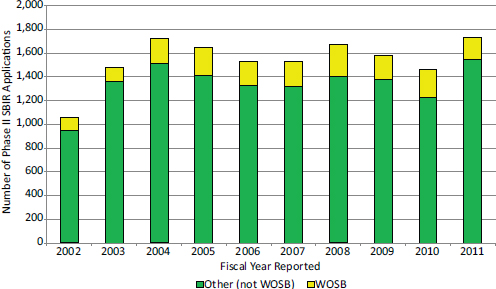
FIGURE 2-21 Phase II SBIR applications by woman-owned small businesses (WOSB), FY2002-2011.
SOURCE: DoD awards and applications database.
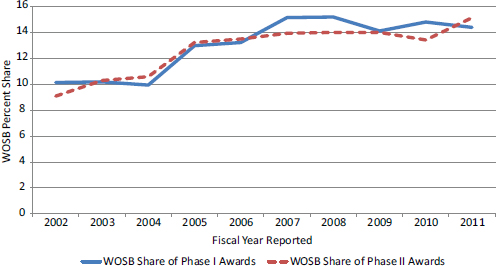
FIGURE 2-22 Woman-owned small business (WOSB) shares of Phase I and Phase II SBIR awards, FY2002-2011.
SOURCE: DoD awards database; DoD SBIR website, accessed August 15, 2013. http://www.acq.osd.mil/osbp/sbir/.
Minority-owned Small Businesses
The basic data for SBIR Phase II awards to MOSBs reveal very low levels of awards throughout the study period, with a sharp decline in more recent years (see Figure 2-23). On average, MOSBs accounted for 7.8 percent of Phase II SBIR awards, with a peak of 11.5 percent in 2008 to a known low of 6 percent in 2010. According to DoD’s data contractor, some inconsistencies remain in the recording of WOSB and MOSB awards at DoD, and the data for 2011 in particular are currently being revised. In part, this decline reflects a decline in the number of Phase II applications by MOSBs (see Figure 2-24).
Figure 2-25 compares Phase II application and award rates for MOSBs. Overall, rates are closely aligned: across the entire study period, MOSBs submitted 7.8 percent of the applications and received 7.9 percent of the awards.4 These results suggest that efforts to expand the number of Phase II awards to MOSBs should focus on encouraging more applications.
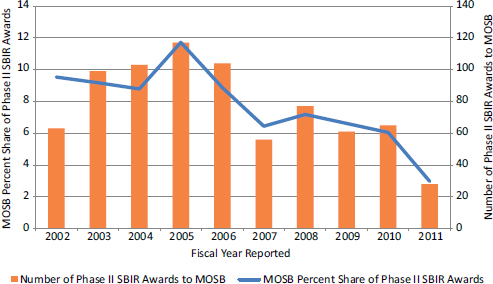
FIGURE 2-23 Phase II SBIR awards to minority-owned small businesses (MOSB), FY2002-2011.
SOURCE: DoD awards and applications database.
__________________
4DoD awards and applications databases.
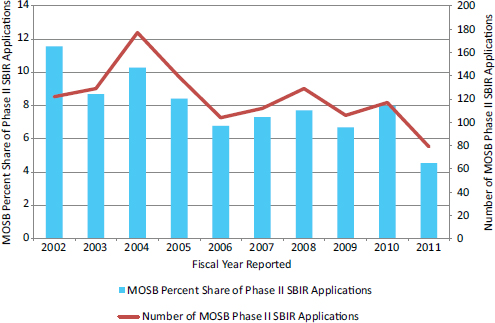
FIGURE 2-24 Phase II SBIR applications by minority-owned small businesses (MOSB), FY2002-2011.
SOURCE: DoD awards and applications database.
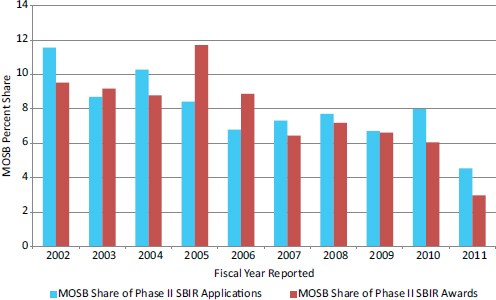
FIGURE 2-25 Phase II SBIR minority-owned small businesses (MOSB) share of awards and applications, FY2002-2011.
SOURCE: DoD awards and applications database.
This page intentionally left blank.












